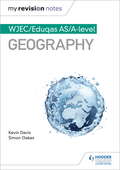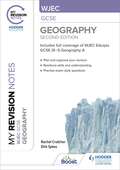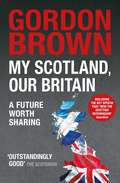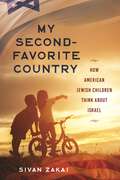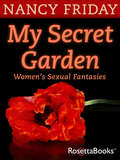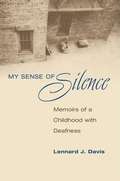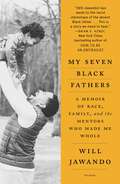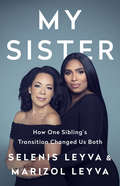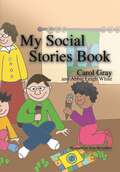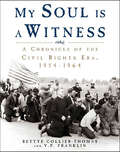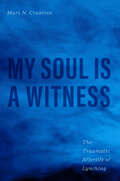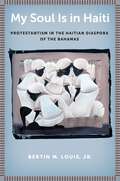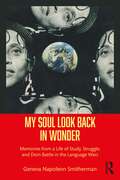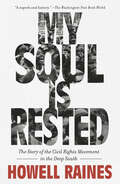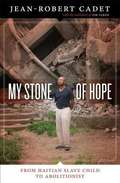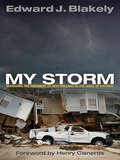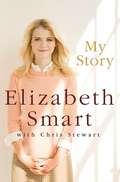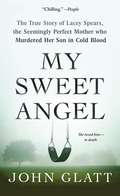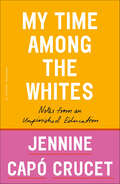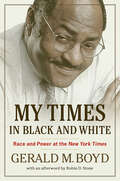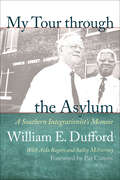- Table View
- List View
My Revision Notes: WJEC AS/A-level Geography (MRN)
by Kevin DavisExam board: WJEC and WJEC EduqasLevel: AS/A-levelSubject: GeographyFirst teaching: September 2016First exams: AS: Summer 2017, A-level: Summer 2018Target success in WJEC and WJEC Eduqas AS/A-level Geography with this proven formula for effective, structured revision.Key content coverage is combined with exam-style tasks and practical tips to create a revision guide that students can rely on to review, strengthen and test their knowledge.With My Revision Notes every student can:- Plan and manage a successful revision programme using the topic-by-topic planner- Consolidate subject knowledge by working through clear and focused content coverage- Test understanding and identify areas for improvement with regular 'Now Test Yourself' tasks and answers- Enhance exam responses using relevant examples and case studies for each topic- Improve exam technique through practice questions, expert tips and examples of typical mistakes to avoidThis revision guide covers the following topics:- Changing landscapes (Coastal landscapes; Glaciated landscapes)- Changing places- Global systems (Water and carbon cycles)- Global governance (Processes and patterns of global migration; Global governance of the Earth's oceans)- Contemporary themes in geography (Tectonic hazards)It also includes exam questions for 21st century challenges.This revision guide is suitable for the following specifications:- 2016 WJEC AS/A-level Geography specification regulated by Qualifications Wales- 2016 WJEC Eduqas AS/A-level Geography specification regulated by Ofqual
My Revision Notes: WJEC GCSE Geography Second Edition
by Dirk Sykes Rachel CrutcherTarget exam success with My Revision Notes. Our updated approach to revisionwill help students learn, practise and apply their skills and understanding. Coverage ofkey content is combined with practical study tips and effective revision strategiesto create a guide that can be relied on to build both knowledge and confidence.My Revision Notes: WJEC GCSE Geography will help students:- Plan and manage revision with our topic-by-topic planner and exam breakdown introduction- Practise and apply skills and knowledge with Exam-style questions and frequent check yourunderstanding questions, and answer guidance online- Build quick recall with bullet- pointed summaries at the end of each chapter- Understand key terms for the exam with user-friendly definitions and a glossary- Avoid common mistakes and enhance exam answers with Examiner tips- Improve subject-specific skills with an Exam skills checkbox at the end of each chapter
My Revision Notes: WJEC GCSE Geography Second Edition
by Dirk Sykes Rachel CrutcherTarget exam success with My Revision Notes. Our updated approach to revisionwill help students learn, practise and apply their skills and understanding. Coverage ofkey content is combined with practical study tips and effective revision strategiesto create a guide that can be relied on to build both knowledge and confidence.My Revision Notes: WJEC GCSE Geography will help students:- Plan and manage revision with our topic-by-topic planner and exam breakdown introduction- Practise and apply skills and knowledge with Exam-style questions and frequent check yourunderstanding questions, and answer guidance online- Build quick recall with bullet- pointed summaries at the end of each chapter- Understand key terms for the exam with user-friendly definitions and a glossary- Avoid common mistakes and enhance exam answers with Examiner tips- Improve subject-specific skills with an Exam skills checkbox at the end of each chapter
My Revision Notes: WJEC/Eduqas AS/A-level Geography
by Kevin DavisExam board: WJEC and WJEC EduqasLevel: AS/A-levelSubject: GeographyFirst teaching: September 2016First exams: AS: Summer 2017, A-level: Summer 2018Target success in WJEC and WJEC Eduqas AS/A-level Geography with this proven formula for effective, structured revision.Key content coverage is combined with exam-style tasks and practical tips to create a revision guide that students can rely on to review, strengthen and test their knowledge.With My Revision Notes every student can:- Plan and manage a successful revision programme using the topic-by-topic planner- Consolidate subject knowledge by working through clear and focused content coverage- Test understanding and identify areas for improvement with regular 'Now Test Yourself' tasks and answers- Enhance exam responses using relevant examples and case studies for each topic- Improve exam technique through practice questions, expert tips and examples of typical mistakes to avoidThis revision guide covers the following topics:- Changing landscapes (Coastal landscapes; Glaciated landscapes)- Changing places- Global systems (Water and carbon cycles)- Global governance (Processes and patterns of global migration; Global governance of the Earth's oceans)- Contemporary themes in geography (Tectonic hazards)It also includes exam questions for 21st century challenges.This revision guide is suitable for the following specifications:- 2016 WJEC AS/A-level Geography specification regulated by Qualifications Wales- 2016 WJEC Eduqas AS/A-level Geography specification regulated by Ofqual
My Scotland, Our Britain
by Gordon BrownMy Scotland, Our Britain: A Future Worth Sharing is a highly personal account of Gordon Brown's Scotland, the nation he was born in, and our Britain, the multinational state that the Scots, English, Welsh and Northern Irish have created and share. Laying bare his family's ancestry over 300 years of the Union and explaining how it shaped his background, Brown charts what it was like growing up in Scotland in the 1950s and 1960s, and explains the influence of religion, education and Scotland's unique industrial structure on the shaping of his and Scotland's identity. He sets out the dramatic economic, social and cultural changes of the past fifty years and the vastly different prospects his children will face, demonstrating that a sense of Scottish national identity has always remained strong and how Scottish institutions have always fiercely guarded their independence. The referendum should not be seen as a battle between Scotland and Britain, he argues, but one between two visions of Scotland's future: one that sees Scotland prosper with a strong Scottish Parliament that is part of the UK, and one that severs all the political links Scots have with the UK. Brown puts forward his proposal for a constitutional settlement that could unite the country, and argues that in tune with Scotland's history of deep engagement with the wider world - as inventors, explorers, traders, missionaries, business leaders and aid workers - the best future for Scots is not to leave Britain, but to continue to shape it.
My Second-Favorite Country: How American Jewish Children Think About Israel
by Sivan ZakaiReveals how young American Jewish children come to develop their views about IsraelIsrael has long occupied a prominent place in the lives and imaginations of American Jews, serving as both a symbolic touchstone and a source of intercommunal conflict. In My Second-Favorite Country, Sivan Zakai offers the first longitudinal study of how American Jewish children come to think and feel about Israel, tracking their evolving conceptions from kindergarten to fifth grade. This work sheds light on the perception of Israel in the minds of Jewish children in the US and provides a rich case study of how children more generally develop ideas and beliefs about self, community, nation, and world. In contrast to popular views of America’s youth as naive or uninterested, this book illuminates both the complexity of their thinking and their desire to be included in conversations about important civic and political matters. Zakai draws from compelling empirical data to prove that children spend considerable effort contemplating the very concepts that adults often assume they are not ready to discuss. Indeed, the book argues that over the course of their elementary school education, children develop and express deep interest in complex issues such as the intricacies of identity and belonging, conflicting ways of framing the past, and the demands of civic responsibility. Ultimately, Zakai argues that in order to take children’s ideas seriously and better prepare them for a world full of disagreement, a substantive shift in educational practices is necessary.
My Secret Garden: Women's Sexual Fantasies
by Nancy FridayThe #1 New York Times–bestselling author&’s &“groundbreaking&” work on women&’s sexual fantasies (Publishers Weekly). First published in 1973, My Secret Garden ignited a firestorm of reactions across the nation—from outrage to enthusiastic support. Collected from detailed personal interviews with hundreds of women from diverse backgrounds, this book presents a bracingly honest account of women&’s inner sexual fantasy lives. In its time, this book shattered taboos and opened up a conversation about the landscape of feminine desire in a way that was unprecedented. Today, My Secret Garden remains one of the most iconic works of feminist literature of our time—and is still relevant to millions of women throughout the world. &“The author whose books about gender politics helped redefine American women&’s sexuality.&” —The New York Times
My Sense of Silence: Memoirs of a Childhood with Deafness
by Lennard J. DavisLennard J. Davis grew up as the hearing child of deaf parents. In this candid, affecting, and often funny memoir, he recalls the joys and confusions of this special world, especially his complex and sometimes difficult relationships with his working-class Jewish immigrant parents. Gracefully slipping through memory, regret, longing, and redemption, My Sense of Silence is an eloquent remembrance of human ties and human failings.
My Seven Black Fathers: A Young Activist's Memoir of Race, Family, and the Mentors Who Made Him Whole
by Will Jawando"Will Jawando's account of mentorship, service, and healing lays waste to the racist stereotype of the absent Black father. By arguing that Black fathers are not just found in individual families, but are indeed the treasure of entire Black communities, Will makes the case for a bold idea: that Black men can counter racist ideas and policies by virtue of their presence in the lives of Black boys and young men. This is a story we need to hear." —Ibram X. Kendi, New York Times–bestselling author of How to be an AntiracistWill Jawando tells a deeply affirmative story of hope and respect for men of color at a time when Black men are routinely stigmatized. As a boy growing up outside DC, Will, who went by his Nigerian name, Yemi, was shunted from school to school, never quite fitting in. He was a Black kid with a divorced white mother, a frayed relationship with his biological father, and teachers who scolded him for being disruptive in class and on the playground. Eventually, he became close to Kalfani, a kid he looked up to on the basketball court. Years after he got the call telling him that Kalfani was dead, another sickening casualty of gun violence, Will looks back on the relationships with an extraordinary series of mentors that enabled him to thrive.Among them were Mr. Williams, the rare Black male grade school teacher, who found a way to bolster Will’s self-esteem when he discovered he was being bullied; Jay Fletcher, the openly gay colleague of his mother who got him off junk food and took him to his first play; Mr. Holmes, the high school coach and chorus director who saw him through a crushing disappointment; Deen Sanwoola, the businessman who helped him bridge the gap between his American upbringing and his Nigerian heritage, eventually leading to a dramatic reconciliation with his biological father; and President Barack Obama, who made Will his associate director of public engagement at the White House—and who invited him to play basketball on more than one occasion. Without the influence of these men, Will knows he would not be who he is today: a civil rights and education policy attorney, a civic leader, a husband, and a father.Drawing on Will’s inspiring personal story and involvement in My Brother’s Keeper, President Obama’s national initiative to address persistent opportunity gaps facing boys and young men of color, My Seven Black Fathers offers a transformative way for Black men to shape the next generation.
My Sister: How One Sibling's Transition Changed Us Both
by Selenis Leyva Marizol LeyvaA powerful memoir by two sisters about transitioning, family, and the path to self-realization.When Orange Is the New Black and Diary of a Future President star Selenis Leyva was young, her hardworking parents brought a new foster child into their warm, loving family in the Bronx. Selenis was immediately smitten; she doted on the baby, who in turn looked up to Selenis and followed her everywhere. The little boy became part of the family. But later, the siblings realized that the child was struggling with their identity. As Marizol transitioned and fought to define herself, Selenis and the family wanted to help, but didn't always have the language to describe what Marizol was going through or the knowledge to help her thrive.In My Sister, Selenis and Marizol narrate, in alternating chapters, their shared journey, challenges, and triumphs. They write honestly about the issues of violence, abuse, and discrimination that transgender people and women of color--and especially trans women of color--experience daily. And they are open about the messiness and confusion of fully realizing oneself and being properly affirmed by others, even those who love you.Profoundly moving and instructive, My Sister offers insight into the lives of two siblings learning to be their authentic selves. Ultimately, theirs is a story of hope, one that will resonate with and affirm those in the process of transitioning, watching a loved one transition, and anyone taking control of their gender or sexual identities.
My Social Stories Book
by Carol Gray Sean McandrewOver the last decade, Carol Gray's Social Stories approach has become established as a highly effective way of teaching social and life skills to children on the autism spectrum. Taking the form of short narratives, the Stories in My Social Stories Book take children step by step through basic activities such as brushing your teeth, taking a bath and getting used to new clothes. It also helps children to understand different experiences such as going to school, shopping and visiting the doctor. These stories are written for preschoolers aged from two to six, and the book is a useful primer for all young children - but most especially those on the autism spectrum. My Social Stories Book contains over 150 Stories, and is illustrated throughout with line drawings by Sean McAndrew, which form a visual counterpart to the text. A helpful introduction explains to parents and carers how to get the most out of the book.
My Son Wears Heels: One Mom's Journey from Clueless to Kickass
by Diane Ehrensaft Julie TarneyIn 1992, Julie Tarney's only child, Harry, told her, "Inside my head I'm a girl." He was two years old. Julie had no idea what that meant. She felt disoriented. Wasn't it her role to encourage and support her child? Surely she had to set some limits to his self-expression--or did she? Would he be bullied? Could she do the right thing? What was the right thing? The internet was no help, because there was no internet. And there were zero books for a mom scrambling to understand a toddler who had definite ideas about his gender, regardless of how Nature had endowed him. Terms such as transgender,gender nonconforming, and gender creative were rare or nonexistent. There were, however, mainstream experts who theorized that a "sissy" boy was the result of a domineering mother. Julie couldn't believe it. She didn't want to care what her neighbors thought, but she did care. "Domineering mother" meant controlling mother. It meant bad mother. It meant her mother. Lacking a positive role model of her own, and fearful of being judged as a mom who was making her son "too feminine," Julie embarked on an unexpected parenting path. Despite some missteps, and with no map to guide her, she learned to rely on her instincts. She listened carefully, kept an open mind, and as long as Harry was happy, she let him lead the way. Julie eventually realized that Harry knew who he was all along. Her job was simply to love and support him unconditionally, allowing him to be his authentic self. This story of a mother embracing her child's uniqueness and her own will resonate with all families.
My Soul Is a Witness: A Chronicle of the Civil Rights Era, 1954–1964
by Bettye Collier-Thomas V. P. FranklinA powerful and inspiring record of one of the most significant periods in America's history, which presents the full historic scope of the hard-fought battle for civil rights.From the landmark Brown v. Board of Education decision, in which legal segregation in public schools was declared unconstitutional, to the Nashville sit-ins organized by the Student Nonviolent Coordinating Committee, and from the Freedom Rides to the March on Washington, to the subsequent passage of the Voting Rights Act of 1965-and covering everything in between--Bettye Collier-Thomas and V. P. Franklin's My Soul Is a Witness is the first comprehensive chronology of the civil rights era in America.This unique chronology extends the examination of civil rights activities beyond the South to include the North, Midwest, and Far West. Although Martin Luther King, Jr. was a towering figure during the era, the authors shift the focus to the thousands of people, places, and events that encompassed the Civil Rights movement. Each entry is based on information found in articles and reports published in three newspaper and periodical sources: The New York Times, Jet Magazine, and the Southern School News. Supplementing the basic chronology are longer features that explore larger topics in more depth and highlight issues well-known at the time but unknown today by scholars and the general public.
My Soul Is a Witness: The Traumatic Afterlife of Lynching (New Directions in Narrative History)
by Mari N. CrabtreeAn intimate look at the afterlife of lynching through the personal stories of Black victims and survivors who lived through and beyond its trauma Mari N. Crabtree traces the long afterlife of lynching in the South through the traumatic memories it left in its wake. She unearths how African American victims and survivors found ways to live through and beyond the horrors of lynching, offering a theory of African American collective trauma and memory rooted in the ironic spirit of the blues sensibility—a spirit of misdirection and cunning that blends joy and pain. Black southerners often shielded their loved ones from the most painful memories of local lynchings with strategic silences but also told lynching stories about vengeful ghosts or a wrathful God or the deathbed confessions of a lyncher tormented by his past. They protested lynching and its legacies through art and activism, and they mourned those lost to a mob’s fury. They infused a blues element into their lynching narratives to confront traumatic memories and keep the blues at bay, even if just for a spell. Telling their stories troubles the simplistic binary of resistance or submission that has tended to dominate narratives of Black life and reminds us that amid the utter devastation of lynching were glimmers of hope and an affirmation of life.
My Soul Is in Haiti: Protestantism in the Haitian Diaspora of the Bahamas
by Bertin M. Louis Jr.Offers a greater understanding of the spread of Protestant Christianity, both regionally and globally, by studying local transformations in the Haitian diaspora of the Bahamas. In the Haitian diaspora, as in Haiti itself, the majority ofHaitians have long practiced Catholicism or Vodou. However, Protestant forms ofChristianity now flourish both in Haiti and beyond. In the Bahamas, whereapproximately one in five people are now Haitian-born or Haitian-descended,Protestantism has become the majority religion for immigrant Haitians.In My Soul Is in Haiti, Bertin M. Louis, Jr. hascombined multi-sited ethnographic research in the United States, Haiti, and theBahamas with a transnational framework to analyze why Protestantism hasappealed to the Haitian diaspora community in the Bahamas. The volumeillustrates how devout Haitian Protestant migrants use their religiousidentities to ground themselves in a place that is hostile to them as migrants,and it also uncovers how their religious faith ties in to their belief in theneed to “save” their homeland, as they re-imagine Haiti politically and morallyas a Protestant Christian nation.This important look at transnational migration betweensecond and third world countries shows how notions of nationalism among Haitianmigrants in the Bahamas are filtered through their religious beliefs. Bystudying local transformations in the Haitian diaspora of the Bahamas, Louisoffers a greater understanding of the spread of Protestant Christianity, bothregionally and globally.
My Soul Look Back in Wonder: Memories from a Life of Study, Struggle, and Doin Battle in the Language Wars
by Geneva Napoleon SmithermanThis is the story of Dr. Geneva Smitherman, aka "Dr. G," the pioneering linguist often referred to as the "Queen of Black Language." In a series of narrative essays, Dr. G writes eloquently and powerfully about the role of language in social transformation and the academic, intellectual, linguistic, and societal debates that shaped her groundbreaking work as a Black Studies O.G. and a Womanist scholar-activist of African American Language. These eleven essays narrate the development of Dr. G’s race, gender, class, and linguistic consciousness as a member of the Black Power Generation of the 1960s and 70s. In My Soul Look Back In Wonder, Dr. G links the personal to the professional and the political, situating the struggles, and successes, of a Black woman in the Academy within the historical experiences and development of her people. As Dr. G enters her eighth decade, in this Black Lives Matter historical moment, she seeks to share the meaning and purpose of a life of study and struggle and its significance for all those who seek racial and social justice today.
My Soul is Rested: The Story of the Civil Rights Movement in the Deep South
by Howell Raines"A superb oral history." —The Washington Post Book World"So touching, so exhilarating...no book for a long time has left me so moved or so happy." —The New York Times Book ReviewThe almost unfathomable courage and the undying faith that propelled the Civil Rights Movement are brilliantly captured in these moving personal recollections. Here are the voices of leaders and followers, of ordinary people who became extraordinary in the face of turmoil and violence. From the Montgomery Bus Boycott in 1956 to the death of Martin Luther King, Jr., in 1968, these are the people who fought the epic battle: Rosa Parks, Andrew Young, Ralph Abernathy, Hosea Williams, Fannie Lou Hamer, and others, both black and white, who participated in sit-ins, Freedom Rides, voter drives, and campaigns for school and university integration.Here, too, are voices from the &“Down-Home Resistance&” that supported George Wallace, Bull Connor, and the &“traditions&” of the Old South—voices that conjure up the frightening terrain on which the battle was fought. My Soul Is Rested is a powerful document of social and political history, as well as a magnificent tribute to those who made history happen.
My Stone of Hope
by Jean-Robert CadetThere are 27 million slaves living in the world today—more than at any time in history. Three hundred thousand of them are impoverished children in Haiti, who “stay with” families as unpaid and uneducated domestic workers, subject to physical, emotional, and sexual abuse. This practice, known locally as restavek (“staying with”), is so widespread that one in ten Haitian children is caught up in this form of slavery. Jean-Robert Cadet was a restavek in Haiti from the late 1950s until the early 1970s. He told the harrowing story of his youth in Restavec: From Haitian Slave Child to Middle-Class American—a landmark book that exposed ongoing child slavery in Haiti. Now in My Stone of Hope, Cadet continues his story from his early attempts to adjust to freedom in American society to his current life mission of eliminating child slavery through advocacy and education. As he recounts his own struggles to surmount the psychological wounds of slavery, Cadet puts a human face on the suffering that hundreds of thousands of Haitians still endure daily. He also builds a convincing case that child slavery is not just one among many problems that Haiti faces as the Western Hemisphere’s poorest nation. Rather, he argues that the systematic abuse of so many of its children is Haiti’s fundamental problem, because it creates damaged adults who seem incapable of governing the country justly or managing its economy productively. For everyone concerned about the fate of Haiti, the welfare of children, and the freedom of people around the globe, My Stone of Hope sounds an irresistible call to action.
My Storm
by Edward J. Blakely Henry CisnerosEdward J. Blakely has been called upon to help rebuild after some of the worst disasters in recent American history, from the San Francisco Bay Area's 1989 Loma Prieta earthquake to the September 11 attacks in New York. Yet none of these jobs compared to the challenges he faced in his appointment by New Orleans Mayor Ray Nagin as Director of the Office of Recovery and Development Administration following Hurricane Katrina.In Katrina's wake, New Orleans and the Gulf Coast suffered a disaster of enormous proportions. Millions of pounds of water crushed the basic infrastructure of the city. A land area six times the size of Manhattan was flooded, destroying 200,000 homes and leaving most of New Orleans under water for 57 days. No American city had sustained that amount of destruction since the Civil War. But beneath the statistics lies a deeper truth: New Orleans had been in trouble well before the first levee broke, plagued with a declining population, crumbling infrastructure, ineffective government, and a failed school system. Katrina only made these existing problems worse. To Blakely, the challenge was not only to repair physical damage but also to reshape a city with a broken economy and a racially divided, socially fractured community.My Storm is a firsthand account of a critical sixteen months in the post-Katrina recovery process. It tells the story of Blakely's endeavor to transform the shell of a cherished American city into a city that could not only survive but thrive. He considers the recovery effort's successes and failures, candidly assessing the challenges at hand and the work done--admitting that he sometimes stumbled, especially in managing press relations. For Blakely, the story of the post-Katrina recovery contains lessons for all current and would-be planners and policy makers. It is, perhaps, a cautionary tale.
My Story
by Chris Stewart Elizabeth SmartFor the first time, ten years after her abduction from her Salt Lake City bedroom, Elizabeth Smart reveals how she survived and the secret to forging a new life in the wake of a brutal crime for the first time, ten years after her abduction from her Salt Lake City bedroom, Elizabeth Smart reveals how she survived and the secret to forging a new life in the wake of a brutal crime. On June 5, 2002, fourteen-year-old Elizabeth Smart, the daughter of a close-knit Mormon family, was taken from her home in the middle of the night by religious fanatic, Brian David Mitchell and his wife, Wanda Barzee. She was kept chained, dressed in disguise, repeatedly raped, and told she and her family would be killed if she tried to escape. After her rescue on March 12, 2003, she rejoined her family and worked to pick up the pieces of her life. Now for the first time, in her memoir, MY STORY, he tells of the constant fear she endured every hour, her courageous determination to maintain hope, and how she devised a plan to manipulate her captors and convinced them to return to Utah, where she was rescued minutes after arriving. Smart explains how her faith helped her stay sane in the midst of a nightmare and how she found the strength to confront her captors at their trial and see that justice was served. In the nine years after her rescue, Smart transformed from victim to advocate, traveling the country and working to educate, inspire and foster change. She has created a foundation to help prevent crimes against children and is a frequent public speaker. In 2012, she married Matthew Gilmour, whom she met doing mission work in Paris for her church, in a fairy tale wedding that made the cover of People magazine.
My Sweet Angel
by John GlattTo the outside world Lacey had seemed like a loving, concerned mother, regularly posting updates on social media about her son's harrowing medical problems. But in reality, Lacey was a textbook case of Munchausen syndrome by proxy.
My Time Among the Whites: Notes from an Unfinished Education
by Jennine Capó CrucetFrom the author of Make Your Home Among Strangers, essays on being an “accidental” American—an incisive look at the edges of identity for a woman of color in a society centered on whitenessIn this sharp and candid collection of essays, critically acclaimed writer and first-generation American Jennine Capó Crucet explores the condition of finding herself a stranger in the country where she was born. Raised in Miami and the daughter of Cuban refugees, Crucet examines the political and personal contours of American identity and the physical places where those contours find themselves smashed: be it a rodeo town in Nebraska, a university campus in upstate New York, or Disney World in Florida. Crucet illuminates how she came to see her exclusion from aspects of the theoretical American Dream, despite her family’s attempts to fit in with white American culture—beginning with their ill-fated plan to name her after the winner of the Miss America pageant.In prose that is both fearless and slyly humorous, My Time Among the Whites examines the sometimes hopeful, sometimes deeply flawed ways in which many Americans have learned to adapt, exist, and—in the face of all signals saying otherwise—perhaps even thrive in a country that never imagined them here.
My Times in Black and White: Race and Power at the New York Times
by Robin Stone Gerald BoydA rags-to-riches story of the climb from urban poverty to the New York Times, this insider's view of struggle and change at the nation's premier newspaper reconstructs the most controversial period in the paper's history and records how journalists reported and edited the biggest events of the past two decades. A candid discussion on race, this memoir is the inspirational story of a man who covered presidents, documented extraordinary social and cultural challenges, led his team to an unprecedented number of Pulitzers, stumbled disastrously during an unjust scandal, and in the end discovered the true value of his life.
My Tour through the Asylum: A Southern Integrationist's Memoir
by Aïda Rogers William E. Dufford Salley McInerney“[A] testament to his journey toward South Carolina’s—not only desegregation of schools—but full integration and voice for African American students.” —Libby Bernardin, author of Stones Ripe for SowingImmortalized in the writings of his most famous student, bestselling author Pat Conroy, veteran education administrator William E. Dufford has led an inspirational life as a stalwart champion for social justice and equal access for all to the empowerment of a good public education. A quintessential Southern storyteller now in his nineties, Dufford reflects on his own transformation through education, from his upbringing in the segregationist Jim Crow Era-South of the 1930s and 1940s to becoming an accomplished integrationist revered by his pantheon of former colleagues and students. In My Tour through the Asylum, several of these supporters share their own candid recollections of Dufford alongside his life story, adding context and anecdotes to the narrative.Dufford credits the evolution of his mindset from segregationist to integrationist to the good influence of two experiences: his service in the US Navy in the 1940s opening his eyes to a larger worldview and his later doctoral training at the University of Florida under nationally recognized professors introducing him to global perspectives of education.Drawing the book title and themes from nineteenth-century statesman James Louis Petigru’s infamous assessment that South Carolina was “too small to be a republic and too big to be an insane asylum,” Dufford offers an insightful, pragmatic, and ultimately hopeful tour through his lived experiences in the courageous, committed service of education and enlightenment.“William Dufford’s memoir is a remarkable example of courage, passion, and determination.” —Peggy B. Winder, Newberry College
